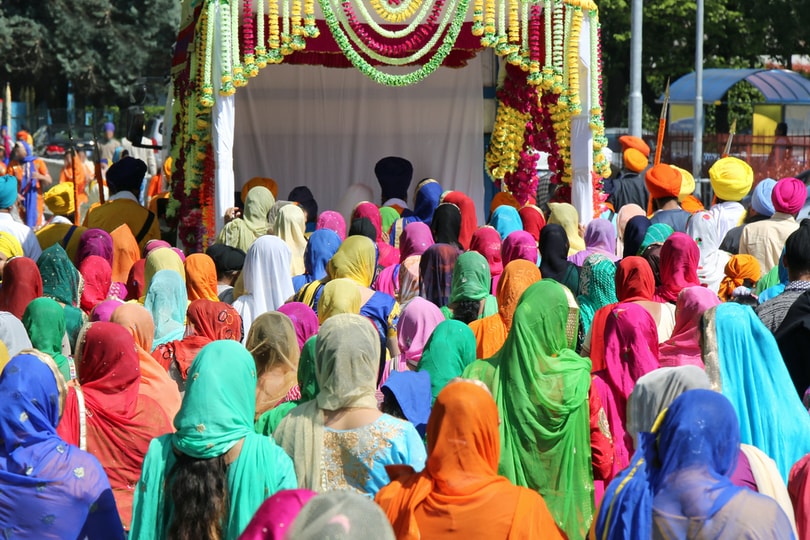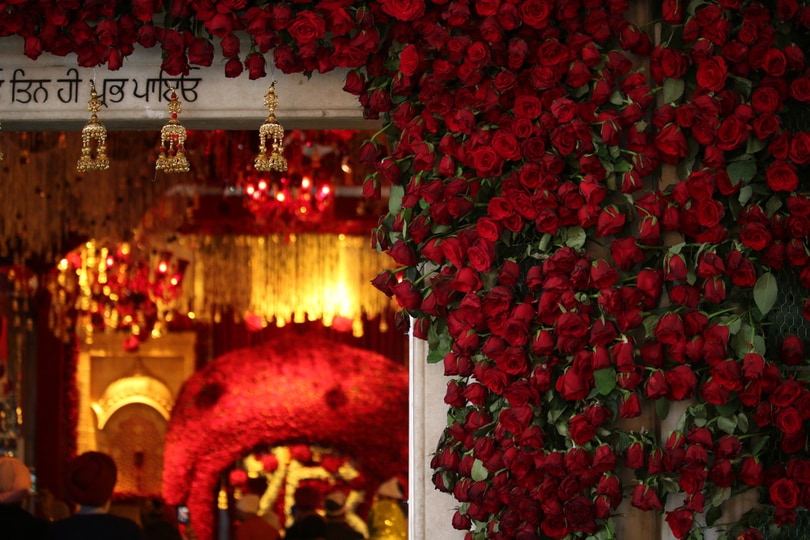The Bounteous Lord heard the anguished cries (of humanity),
and so, Guru Nanak, He sent to this world of woe.” – Bhai Gurdas Ji
Guru Nanak Jayanti also is known as Guru Nanak Gurupurab celebrates the birth of the first Sikh Guru Guru Nanak. Guru Nanak Ji was the founder of Sikhism and the first of ten Sikh Gurus. He was born in 1469 at Nankana Sahib in Punjab (modern-day Pakistan). His father was the local tax collector of the village. Many accounts tell of Nanak’s early spiritual awakening. He was said to be a precocious child with particular insights into religious teachings and philosophy. He was born into a Hindu family and was inquisitive right from his childhood. He studied both Hinduism and Islam and adopted their good practices and rejected the dogma. He had a deep interest in religion and theology, however, he did not want to accept any practice without questioning it. At the age of eleven, when the boys of his caste were wearing visible symbols of their caste, Nanak refused to don any such symbol arguing that caste is not the basis to judge anyone. Nanak would often debate with religious pundits about the nature of God and true religious practice.
Nanak taught that God was beyond religious dogma and external definition. He said he would follow neither the Muslim or Hindu religion, but just God’s path. He taught ‘there is no Muslim, no Hindu’. This was of social significance because of the political and social conflict between Islam and Hinduism at the time. During his lifetime, Guru Nanak attracted followers from the Hindu, Muslim, and other religious sects. Guru Nanak received many distinguished visitors but always refused material gifts, believing that spiritual teaching should be given freely and not be dependent on financial payment.
Guru Nanak Jayanti is the day that celebrates the life and achievements of this great spiritual leader. Guru Nanak’s birthday is celebrated all over India especially in the state of Punjab where Sikhism is widely prevalent. Punjabi communities in other states also celebrate the festival. The birthday of Guru Nanak Sahib usually falls on Kartik Puranmashi, which is the full moon day of the month Kartik according to the Indian calendar. Needless to say, Guru Nanak Dev Ji’s birthday is celebrated with great enthusiasm.

Guru Nanak Dev Ji was the founder and first Guru of Sikhism. He was born in the year 1469 in the Talwandi village situated in the Punjab region of the Indian subcontinent. The village, now known as Nankana Sahib, lies near the city of Lahore in present-day Pakistan. Sikhs around the world celebrate the auspicious occasion of Guru Nanak Dev Ji’s birth on the Pooranmashi (full moon) in the Lunar month of Kartik (October-November), which falls on a different date every year.
Guru Nanak’s father, Mehta Kalu Ji, was a village accountant. His mother, Mata Tripta Ji, was described as a simple and religious woman. He also had an older sister named Bebe Nanki Ji. Right from his birth, Nanak showed extraordinary qualities. It appeared as if he was destined for greatness. He was blessed with a beautiful mind – deeply contemplative and empathetic. He used to astound his elders and teachers with his mature understanding of things and sublimity of knowledge, particularly concerning divine matters. Growing up, he refused to partake in traditional religious rituals and often spoke out against several prevalent societal practices such as the Caste System, idolatry, and the worship of demi-Gods. By the time he turned sixteen, he had gained mastery over various religious texts and languages including Sanskrit, Persian, and Hindi, and was already writing compositions inspired by divinity.
In the year 1487, Guru Nanak was married to Mata Sulakhni Ji, and they had two sons, Sri Chand and Lakhmi Das. The family, accompanied by Bhai Mardana, a Muslim childhood friend of Guru Nanak, then moved to the town of Sultanpur Lodhi. He used to sing hymns accompanied by Bhai Mardana on the rabab- a stringed instrument. During one of those early mornings, while bathing in Vain Nadi (a small river), Guru Nanak heard God‘s voice telling him to dedicate himself completely to the service of humanity. The very first sentence which he uttered then was, “There is no Hindu, no Musalman (Muslim)”. Stating that he had been taken to the God’s court and given a divine mission, Guru Nanak then began the next stage of his life – to preach his unique doctrine (Sikhi) to the entire world.
For the next 30 years, Guru Nanak, accompanied by Bhai Mardana, undertook four major spiritual journeys across continents to preach his message of Sikhi. He believed God to be “Supreme, All-powerful and Truthful, Formless (Nirankar), Fearless (Nirbhau), Without hate (Nirvair), the Sole (Ik), the Self-Existent (Saibhang), the Incomprehensible and Everlasting creator of all things (Karta Purakh), and the Eternal and Absolute Truth (Satnam)”.
In the later years of his life, Guru Nanak Ji founded and settled down at the township of Kartarpur (creator’s town) on the banks of the river Ravi in Punjab. Here, he donned the robes of a peasant, earning his honest living by cultivating the lands. Followers came from near and far to listen to the Master. He introduced the institution of Langar (free communal kitchen) at Kartarpur, establishing the basic equality of all people regardless of their social and economic status. If you have been following the news, you would know that both India and Pakistan are working tirelessly towards opening a Kartarpur Corridor. The corridor is highly significant because Kartarpur was founded by Guru Nanak Ji, and there is a Gurdwara honoring him there.
In the year 1539, knowing that the end was drawing near, Guru Ji – after having tested his own two sons and some followers over the years – installed Bhai Lehna Ji (Guru Angad Dev Ji) as the Second Nanak, and after a few days passed into Sachkhand- the realm of truth.
His followers celebrate the life and legacy of Guru Nanak on his birthday. Punjab is known as the land of hearty people, so, the birthday of Guru Nanak Ji is celebrated with great love, devotion, and enthusiasm.

Gurpurab celebrations begin at least two days in advance with the reading of the Guru Granth Sahib, the holy book of the Sikh community. Called Akhand Path, it is a 48-hour-long, non-stop reading of the book.
The next day, a grand procession is organized. It is headed by the five beloved ones or panj pyaras and they carry the Sikh flag and the Guru Granth Sahib in a palanquin. This part of the celebration is called Nagarkirtan. Some singers follow the five people and sing hymns as the procession goes into the streets and pass on the teachings of Guru Nanak. These streets are usually decorated with Sikh flags and flowers and people join the procession with great spiritual fervor. In many places, martial arts performances are organized along with music and dhol. These performances sometimes display mock battles. The purpose of this event is to celebrate the life and times of Guru Nanak Ji and encourage more and more people to follow in his footsteps. You will usually find community leaders walking along the procession and sharing the Sikh gurus’ teachings. Other devotees also join in to make it a successful celebration.
On the day of Guru Nanak Jayanti, the celebrations begin before dawn at around 4 am. People head to the gurdwara and sing morning hymns. Each Sikh guru has a set of different hymns that are sung on their birth anniversary. After this session, people assemble for a reading from the holy book known as the Katha. Post this, people often attend kirtan where songs are sung in praise of Guru Nanak. Any gurudwara you go to, the festivities do not get over without a community feast called langar. This is served to everyone and anyone who comes to the gurdwara, irrespective of their caste, creed or religion. On Gurpurab, there are special delicacies made as an offering to the founder of the Sikh community on his birthday. The food is made in a community kitchen in the gurdwara itself. The food is served with love in the spirit of service and devotion. You will find several people apart from members of the Sikh community making their way to the gurdwara to attend the langar.
But this is not the end of the celebration, in some of the gurudwaras, celebrations are also held in the night. These festivities begin post-sunset and go on until late at night. After offering prayers, devotees sing along in the kirtan session. Around 1:20 am, they sing Gurbani which refers to compositions by the Sikh gurus from the Guru Granth Sahib. This is done as it is believed that Guru Nanak was born at 1:20 am. After this, the celebrations wrap up by 2 am and people head home. Guru Nanak Jayanti is one of the most important festivals for Sikhs and states like Punjab and Haryana are where you will find a grand celebration.
Guru Nanak Jayanti is celebrated with a lot of color and enthusiasm in Gurudwaras all over India. Let’s explore some of the best places to experience this exhilarating festival.

The Golden Temple, also known as Harmandir Sahib is considered the holiest place of worship by the followers of Sikhism. The structure of this grand Gurudwara is built lower than the ground level to symbolize the values of humanity and egalitarianism.
During Guru Nanak Jayanti they organize massive langars- community kitchen. Langar is a usual feature here but during the festival it acquires more significance. The Langar coupled with the Akhand Path and the selfless service of the devotees make Guru Nanak Jayanti truly a special event here. The Akal Takht is illuminated on Guru Nanak’s birthday here and it makes for a beautiful sight.
Pakistan, being the birthplace of Guru Nanak ji, lies dotted with many Gurdwaras dedicated to him. One of the most famous Gurudwaras there is Gurudwara Darbar Sahib at Kartarpur. It is believed to be the place where Guru Nanak settled after his missionary work, and attained joti jot (passed away) in 1539.

It is arguably the most important Gurduwara for Sikhs because Nankana Sahib was the birthplace of Guru Nanak ji. Another gem across the border, this Gurudwara attracts pilgrims all year round. Nanak was born here in the 15th Century and the Nankana Sahib Gurudwara is mentioned in the daily prayer or ‘ardasa’ of the Sikhs. The township was originally called Rai-Bhoi-Di-Talwandi but was renamed Nankana Sahib later. Approximately 80km from Lahore, the gurdwara boasts a garden and a pool of holy water. This year, a group of over 500 Sikh pilgrims entered India from Pakistan via road on Thursday after paying obeisance at the historic Nankana Sahib as part of the 550th birth anniversary celebrations of Guru Nanak Dev.
Visit the dazzling hill-station of Kullu on Guru Nanak Jayanti, and pay respects at this Gurudwara erected in the memory of Guru Nanak. According to the legend, this area was once visited by Guru Nanak ji and his congregation of Sikhs. They were all hungry after the long journey but had no food. The followers helped arrange some food but there was no fire to cook it. It is believed that Guru Nanak then lifted a rock and out of it appeared a hot spring.
It is believed that a dip in the hot spring there can cure you of your ailments. What better occasion to do this on than Guru Nanak Jayanti?
One of the nine historical Gurudwaras in Delhi, Gurudwara Sis Ganj commemorates the martyrdom of the ninth Sikh Guru, Guru Teg Bahadur. Situated in the winding alleys of Chandni Chowk in Old Delhi, this Gurudwara attracts devotees from all over the world. On 11th November, 1675, at this very spot where the Gurudwara exists now, Guru Tegh Bahadur was beheaded at the orders of the Mughal Emperor Aurangzeb for refusing to convert to Islam. Before his body could be displayed for public viewing, it was stolen by one of his followers- Lakhi Shah Banjara- who burnt his house to cremate the Guru’s body with honor. Today there lies a Gurudwara at the site of his cremation- Gurudwara Sis Ganj Sahib.
Guru Nanak Jayanti is a beautiful festival that celebrates the teachings of the first Sikh Guru, Guru Nanak Dev Ji. You should plan a visit to any of the above-mentioned Gurudwaras around this time. The best place to celebrate the festival in India is Amritsar. You can either choose to stay in the Gurudwara, which is a beautiful experience in itself, or in one of the many hotels near the Gurudwaras. You can also celebrate the festival by performing sewa to the thousands of devotees who visit these Gurudwaras to seek the blessings of their Guru.

Please go back to portrait mode for the best experience